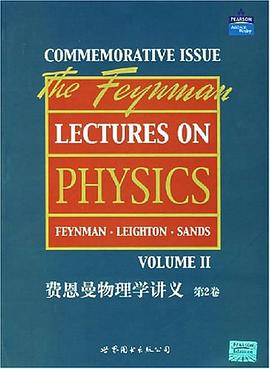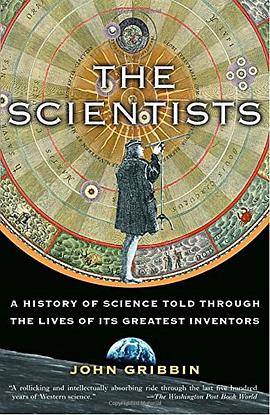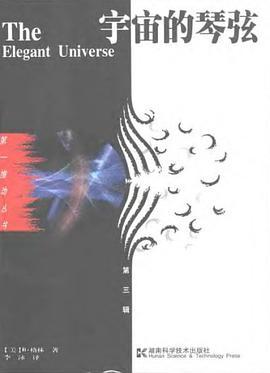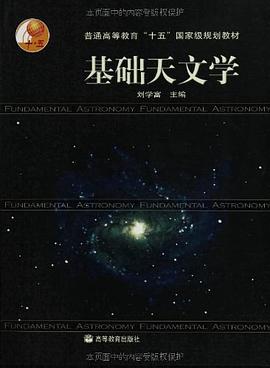

具体描述
《费恩曼物理学讲义》(第2卷)讲述当时美国大学物理教学改革试图解决的一个主要问题是基础物理教学应尽可能反映近代物理的巨大成就。《费恩曼物理学讲义》在基础物理的水平上对20世纪物理学的两大重要成就——相对论和量子力学——作了系统的介绍,对于量子力学,费恩曼教授还特地准备了一套适合大学二年级水平的讲法。教学改革试图解决的另一个问题是按照当前物理学工作者在各个前沿研究领域所使用的方式来介绍物理学的内容。在《费恩曼物理学讲义》一书中对一些问题的分析和处理方法反映了费恩曼自己以及其他在前沿研究领域工作的物理学家所通常采用的分析和处理方法。全书对基本概念、定理和定律的讲解不仅生动清晰,通俗易懂,而且特别注重从物理上作出深刻的叙述。为了扩大学生的知识面,全书还列举了许多基本物理原理在各个方面(诸如天体物理、地球物理、生物物理等)的应用,以及物理学的一些最新成就。由于全书是根据课堂讲授的录音整理编辑的,它在一定程度保留了费恩曼讲课的生动活泼、引人入胜的独特风格。《费恩曼物理学讲义》从普通物理水平出发,注重物理分析,深入浅出,避免运用高深烦琐的数学方程,因此具有高中以上物理水平和初等微积分知识的读者阅读起来不会感到十分困难。至于大学物理系的师生物理工作者更能从此书中获得教益。1989年,为纪念费恩曼逝世一周年,原书编者重新出版本书,并增加了介绍费恩曼生平的短文和新的序言。我们按照新版的原本进行了翻译。
作者简介
费恩曼(R.P.Feynman)1918年生于布鲁克林区,1942年在普林斯顿获得博士学位。第二次世界大战期间在洛斯阿拉莫斯,尽管当时他还很年轻,但已在曼哈顿计划中发挥了重要作用。以后,他在康奈尔大学和加利福尼亚理工学院任教。1965年,因他在量子电动力学方面的工作和朝永振一郎及施温格(J.Schwinger)同获诺贝尔物理学奖。
费因曼博士获得诺贝尔奖是由于成功地解决了量子电动力学理论问题,他也创立了说是液氦中起流动性现象的数学理论。此后,他和盖尔曼(M.Gell-Mann)在B衰变等弱相互作用领域内做出了奠基性的工作。在以后的几年里,他在夸克理论的发展中起了关键性的作用,提出了他的高能质子碰撞过程的部分子模型。
除了这些成就之外,费恩曼博士将新的基本计算技术及记号法引时物理学,首先是无处不在的费恩曼图,在近代科学历史中,它比任何其他数学形式描述都更大地改变了对基本物理过程形成概念及进行计算的方法。
费恩曼是一位卓越的教育家。在他区得的许多奖项中,他对1972年获得的奥斯特教学奖章特别感到自豪。在1963年第一次出版的《费恩曼物理学讲义》被《科学叛国人》杂志的一位评论员描写为“咬不动但富于营养并且津津有味。25年后它仍是教师和最好的初学学生的指导书”。为了使外行的公众增加对物理学的了解,费恩曼博士写了《物理定律和量子电动力学的性质:光和物质的奇特理论》。他还是许多高级出版物的作者,这些都成为研究人员和学生的经典参考书和教科书。
费恩曼是一个活跃的公众人物。他在挑战者号调查委员会里的工作是从所周知的,特别是他的著名的O型环对寒冷的敏感性的演示,这是一个优美的实验,除了一杯冰水以外其他什么也不需要。费恩曼博士1960年在加利福尼亚州课程促进会中的工作却很少人知道,他在会上抨击了教材的平庸。
仅仅罗列费恩曼的科学和教育成就并没有恰当抓信这个人的本质。即使是他 最最技术性的出版物的读者都知识道,费恩曼活跃的多面的人格在他所有的工作中都闪闪发光。除了作为物理学家,在各种不同的场合下他变成不同的人物:有进是无线电修理工,有时是锁具收藏家,艺术家、舞蹈家、邦戈(bongo)鼓手,甚至玛雅象形文字的解释者。对他的世界人们永远好奇,他是一个典型的经验主义者。
费恩曼于1998年2月15日在洛杉矶逝世。
目录信息
1-1 electrical forces 1-1
1-2 electric and magnetic felds 1-3
1-3 characteristics of vector fields 1-4
1-4 the laws of electromagnetism i-5
i-5 what are the fields? 1-9
1-6 electromagnetism in science and technology 1-10
chapter 2. differential calculus of vector fields
2-1 understanding physics 2-1
2-2 scalar and vector fields—t and h 2-2
2-3 derivatives of fields—the gradient 2-4
2-4 the operator v 2-6
2-5 operations with v 2-7
2-6 the differential equation of heat flow 2-8
2-7 second derivatives of vector fields 2-9
2-8 pitfalls 2-11
chapter 3. vector integral calculus
3-1 vector integrals; the line integral of v,it 3-1
3-2 the flux of a vector field 3-2
3-3 the flux from a cube; gauss' theorem 3-4
.3-4 heat conduction; the diffusion equation 3-6
3-5 the circulation of a vector field 3-8
3-6 the circulation around a square;
stokes' theorem 3-9
3-7 curl-free and divergence-free fields 3-10
3-8 summary 3-11
chapter 4. electrostatics
4-1 statics 4—1
4-2 coulomb's law; superposition 4-2
4-3 electric potential 4-4
4-4 e=- φ 4-6
4-5 the flux of e 4-7
4-6 gauss' law; divergence of e 4-9
4-7 field of a sphere of charge 4-10
4-8 field lines; equipotential surfaces 4-1l
chapter 5. application of gauss' law
5-1 electrostatics is gauss's law plus . . . 5-1
5-2 equilibrium in an electrostatic field 5-1
5-3 equilibrium with conductors 5-2
5-4 stability of atoms 5-3
5-5 the field of a line charge 5-3
5-6 a sheet of charge; two sheets 5-4
5-7 a sphere of charge; a spherical shell 5-4
5-8 is the field of a point charge exactly 1/r2? 5-5
5-9 the fields of a conductor 5-7
5-10 the field in a cavity of a conductor 5-8
chapter 6. the electric field in various
circumstances
6-1 equations of the electrostatic potential 6-1
6-2 the electric dipole 6-2
6-3 remarks on vector equations 6-4
6-4 the dipole potential as a gradient 6-4
6-5 the dipole approximation for an arbitrary
distribution 6-6
6-6 the fields of charged conductors 6-8
6-7 the method of images 6-8
6-8 a point charge near a conducting plane 6-9
6-9 a point charge near a conducting sphere 6-10
6-10 condensers; parallel plates 6-11
6-11 high-voltage breakdown 6-13
6-12 the field-emission microscope 6-14
chapter 7. the electric field in various
circumstances (continued)
7-1 methods for finding the electrostatic field 7-1
7-2 two-dimensional fields; functions of the complex
variable 7-2
7-3 plasma oscillations 7-5
7—4 colloidal particles in an electrolyte 7-8
7-5 the electrostatic field of a grid 7-10
chapter 8. electrostatic energy
8-1 the electrostatic energy of charges. a uniform
sphere 8-t
8-2 the energy of a condenser. forces on charged
conductors 8-2
8-3 the electrostatic energy of an ionic crystal 8-4
8-4 electrostatic energy in nuclei 8-6
8-5 energy in the electrostatic field 8-9
8-6 the energy of a point charge 8-12
chapter 9. electricity in the atmosphere
9-1 the electric potential gradient of the
atmosphere 9-1
9-2 electric currents in the atmosphere 9-2
9-3 origin of the atmospheric currents 9-4
9-4 thunderstorms 9-5
9-5 the mechanism of charge separation 9-7
9-6 lightning 9-10
chapter 10. dielectrics
10-1 the dielectric constant 10-1
10—2 the polarization vector p 10-2
10-3 polarization charges 10-3
10-4 the electrostatic equations with dielectrics 10-6
10-5 fields and forces with dielectrics 10-7
chapter 11. inside dielectrics
11-1 molecular dipoles 11-1
11-2 electronic polarization 11-1
11-3 polar molecules; orientation polarization 11-3
11-4 electric fields in cavities of a dielectric 11-5
11-5 the dielectric constant of liquids; the clausius-
mossotti equation 11-6
11-6 solid dielectrics 11-8
11-7 ferroelectricity; batioa 11-8
chapter 12. electrostatic analogs
12-1 the same equations have the same solutions 12-1
12-2 the flow of heat; a point source near an infinite
plane boundary 12-2
12-3 the stretched membrane 12-5
12-4 the diffusion of neutrons; a uniform spherical
source in a homogeneous medium 12-6
12-5 irrotational fluid flow; the flow past a sphere 12-8
12-6 illumination; the uniform lighting of a plane 12-10
12-7 the "underlying unity" of nature 12-12
chapter 13. magnetostatics
13-1 the magnetic field 13-1
13-2 electric current; the conservation of charge 13-1
13-3 the magnetic force on a current 13-2
13-4 the magnetic field of steady currents;
ampere's law 13-3
13-5 the magnetic field of a straight wire and of a
solenoid; atomic currents 13-5
13-6 the relativity of magnetic and electric fields 13-6
13-7 the transformation of currents and charges 13-11
13-8 superposition; the right-hand rule 13-11
chapter 14. the magnetic field in various
situations
14-1 the vector potential 14-1
14-2 the vector potential of known currents 14-3
14-3 a straight wire 14-4
14-4 a long solenoid 14-5
14-5 the field of a small loop; the magnetic dipole 14-7
14-6 the vector potential of a circuit 14-8
14-7 the law of blot and savart 14-9
chapter 15. the vector potential
15-1 the forces on a current loop; energy of
a dipole 15-1
15-2 mechanical and electrical energies 15-3
15-3 the energy of steady currents 15-6
15-4 b versus a 15-7
15-5 the vector potential and quantum mechanics 15-8
15-6 what is true for statics is false for dynamics 15-14
chapter 16. induced currents
16-1 motors and generators 16-1
16-2 transformers and inductances 16-4
16-3 forces on induced currents 16-5
16-4 electrical technology 16-8
chapter 17. the laws of induction
17-1 the physics of induction 17-1
17-2 exceptions to the "flux rule" 17-2
17-3 particle acceleration by an induced electric field;
the betatron 17-3
17-4 a paradox 17-5
17-5 alternating-current generator 17-6
17-6 mutual inductance 17-9
17-7 self-inductance 17-11
17-8 inductance and magnetic energy 17-12
chapter 18. the maxwell equations
18-1 maxwell's equations 18-1
18-2 how the new term works 18-3
18-3 all of classical physics 18-5
18-4 a travelling field 18-5
18-5 the speed of light 18-8
18-6 solving maxwell's equations; the potentials and the
wave equation 18-9
chapter 19. the principle of least action
a special lecture—almost verbatim 19-1
a note added after the lecture 19-14
chapter 20. solutions of maxwell's equations
in free space
20-1 waves in free space; plane waves 20-1
20-2 three-dimensional waves 20-8
20-3 scientific imagination 20-9
20-4 spherical waves 20—12
chapter 21. solutions of maxwell's equations ..
with currents and charges
21-1 light and electromagnetic waves 21-1
21-2 spherical waves from a point source 21-2
21-3 the general solution of maxwell's equations 21-4
21-4 the fields of an oscillating dipole 21-5
21-5 the potentials of a moving charge; the general
solution of lienard and wiechert 21-9
21-6 the potentials for a charge moving with constant
velocity; the lorentz formula 21-12
chapter 22. ac circuits
22-1 impedances 22-1
22-2 generators 22-5
22-3 networks of ideal elements; kirchhoff's rules 22-7
22-4 equivalent circuits 22-10
22-5 energy 22-11
22-6 a ladder network 22-12
22-7 filters 22-14
22-8 other circuit elements 22-16
chapter 23. cavity resonators
23-1 real circuit elements 23-1
23-2 a capacitor at high frequencies 23-2
23-3 a resonant cavity 23-6
23-4 cavity modes 23-9
23-5 cavities and resonant circuits 23-10
chapter 24. waveguides
24-1 the transmission line 24-1
24-2 the rectangular waveguide 24-4
24-3 the cutoff frequency 24-6
24-4 the speed of the guided waves 24-7
24-5 observing guided waves 24-7
24-6 waveguide plumbing 24-8
24-7 waveguide modes 24-10
24-8 another way of looking at the guided waves 24-10
chapter 25. electrodynamics in relativistic
notation
25-1 four-vectors 25-1
25-2 the scalar product 25-3
25-3 the four-dimensional gradient 25-6
25-4 electrodynamics in four-dimensional notation 25-8
25-5 the four-potential of a moving charge 25-9
25-6 the invariance of the equations of
electrodynamics 25-10
chapter 26. lorentz transformations of the fields
26-1 the four-potential of a moving charge 26-1
26-2 the fields of a point charge with a constant
velocity 26-2
26-3 relativistic transformation of the fields 26-5
26-4 the equations of motion in relativistic
notation 26-11
chapter 27. field energy and field momentum
27-1 local conservation 27-1
27-2 energy conservation and electromagnetism 27-2
27-3 energy density and energy flow in the
electromagnetic field 27-3
27-4 the ambiguity of the field energy 27-6
27-5 examples of energy flow 27-6
27-6 field momentum 27-9
chapter 28. electromagnetic mass
28-1 the field energy of a point charge 28-1
28-2 the field momentum of a moving charge 28-2
28-3 electromagnetic moss 28-3
28-4 the force of an electron on itself 28-4
28-5 attempts to modify the maxwell theory 28-6
28-6 the nuclear force field 28-12
chapter 29. the motion of charges in electric
and magnetic fields
29-1 motion in a uniform electric or magnetic field 29-1
29-2 momentum analysis 29-1
29-3 an electrostatic lens 29-2
29-4 a magnetic lens 29-3
29-5 the electron microscope 29-3
29-6 accelerator guide fields 29-4
29-7 alternating-gradient focusing 29-6
29-8 motion in crossed electric and magnetic fields 29-8
chapter 30. the internal geometry of crystals
30-1 the internal geometry of crystals 30-1
30-2 chemical bonds in crystals 30-2
30-3 the growth of crystals 30-3
30-4 crystal lattices 30-3
30-5 symmetries in two dimensions 30-4
30-6 symmetries in three dimensions 30-7
30-7 the strength of metals 30-8
30-8 dislocations and crystal growth 30-9
30-9 the bragg-nye crystal model 30-10
chapter 31. tensors
31-1 the tensor of polarizability 31-1
31-2 transforming the tensor components 31-3
31-3 the energy ellipsoid 3 i-3
31-4 other tensors; the tensor of inertia 31-6
31-5 the cross product 31-8
31-6 the tensor of stress 31-9
31-7 tensors of higher rank 31-11
31-8 the four-tensor of electromagnetic
momentum 31-12
chapter 32. refractive index of dense materials
32-1 polarization of matter 32-1
32-2 maxwell's equations in a dielectric 32-3
32-3 waves in a dielectric 32-5
32-4 the complex index of refraction 32-8
32-5 the index of a mixture 32-8
32-6 waves in metals 32-10
32-7 low-frequency and high-frequency approximations;
the skin depth and the plasma frequency 32-11
chapter 33. reflection from surfaces
33-1 reflection and refraction of light 33-1
33-2 waves in dense materials 33-2
33-3 the boundary conditions 33-4
33-4 the reflected and transmitted waves 33-7
33-5 reflection from metals 33-11
33-6 total internal reflection 33-12
chapter 34. the magnetism of matter
34-1 diamagnetism and paramagnetism 34-1
34-2 magnetic moments and angular momentum 34-3
34-3 the precession of atomic magnets 34-4
34-4 diamagnetism 34-5
34-5 larmor's theorem 34-6
34-6 classical physics gives neither diamagnetism nor
paramagnetism 34-8
34-7 angular momentum in quantum mechanics 34-8
34-8 the magnetic energy of atoms 34-11
chapter 35. paramagnetism and magnetic resonance
35-1 quantized magnetic states 35-1
35-2 the stern-gerlach experiment 35-3
35-3 the rabi molecular-beam method 35-4
35-4 the paramagnetism of bulk materials 35-6
35-5 cooling by adiabatic demagnetization 35-9
35-6 nuclear magnetic resonance 35-10
chapter 36. ferromagnetism
36-1 magnetization currents 36-1
36-2 the field h'36-5
36-3 the magnetization curve 36-6
36-4 iron-core inductances 36-8
36-5 electromagnets 36-9
36-6 spontaneous magnetization 36-11
chapter 37. magnetic materials
37-1 understanding ferromagnetism 37-1
37-2 thermodynamic properties 37-4
37-3 the hysteresis curve 37-5
37-4 ferromagnetic materials 37-10
37-5 extraordinary magnetic materials 37-11
chapter 38. elasticity
38-1 hooke's law 38-1
38-2 uniform strains 38-2
38-3 the torsion bar; shear waves 38-5
38-4 the bent beam 38-9
38-5 buckling 38-i1
chapter 39. elastic materials
39-1 the tensor of strain 39-1
39-2 the tensor of elasticity 39-4
39-3 the motions in an elastic body 39-6
39-4 nonelastic behavior 39-8
39-5 calculating the elastic constants 39-10
chapter 40. the flow of dry water
40-1 hydrostatics 40-1
40-2 the equations of motion 40-2
40-3 steady fiow—bernoulli's theorem 40-6
40-4 circulation 40-9
40-5 vortex lines 40-10
chapter 41. the flow of wet water
41-1 viscosity 41-1
41-2 viscous flow 41-4
41-3 the reynolds number 41-5
4l-4 flow past a circular cylinder 41-7
41-5 the limit of zero viscosity 41-9
41-6 couette flow 41-10
chapter 42. curven space
42-1 curved spaces with two dimensions 42-1
42-2 curvature in three-dimensional space 42-5
42-3 our space is curved 42-6
42-4 geometry in space-time 42-7
42-5 gravity and the principle of equivalence 42-8
42-6 the speed of clocks in a gravitational field 42-9
42-7 the curvature of space-time 42-11
42-8 motion in curved space-time 42-12
42-9 einstein's theory of gravitation 42-13
· · · · · · (收起)
读后感
还记得在上大学的时候在图书馆里借过这本书,虽然已经过去7-8年了,但还是能记得里面的一些漂亮的插图。这是一本不枯燥的物理书。
评分网上电磁学的公开课比较容易找到的是MIT的《电与磁》,老教授讲得非常好,用了各种仪器,看得我十分欢喜。 只不过,《电与磁》只停留在基础物理的部分,没有进行更深入的电磁学探讨。 电动力学的教学视频,终于被找到了,我们这些非物理专业的有福了~ 台湾大学的进阶电磁学...
评分“据联合小组研究成员彭承志教授介绍,量子态隐形传输是一种全新的通信方式,它传输的不再是经典信息而是量子态携带的量子信息,它是未来量子通信网络的核心要素。利用量子纠缠技术,需要传输的量子态如同科幻小说中描绘的“超时空穿越”,在一个地方神秘地消失,不需要任何载...
评分显然久已明白,高耸的东西常受雷击。波斯王薛西斯的顾问阿塔班尼斯曾有一句名言,那是当薛西斯企图把整个已知世界都归由波斯人管辖而出征时,他给予他的主子关于对希腊的一次预谋攻击的忠告。阿塔班尼斯说:“看上帝怎样利用他的闪电来毁灭那些大的野兽,他不能容忍它们逐渐变...
评分显然久已明白,高耸的东西常受雷击。波斯王薛西斯的顾问阿塔班尼斯曾有一句名言,那是当薛西斯企图把整个已知世界都归由波斯人管辖而出征时,他给予他的主子关于对希腊的一次预谋攻击的忠告。阿塔班尼斯说:“看上帝怎样利用他的闪电来毁灭那些大的野兽,他不能容忍它们逐渐变...
用户评价
英语看不大懂。。。嗷!!基本上处于看公式猜文章含义的阶段,颇为欢乐
评分呼。。第二卷啃完(:з」∠)_
评分Great book!
评分10 月 14 日至12 月 6 日
评分英语看不大懂。。。嗷!!基本上处于看公式猜文章含义的阶段,颇为欢乐
相关图书
本站所有内容均为互联网搜索引擎提供的公开搜索信息,本站不存储任何数据与内容,任何内容与数据均与本站无关,如有需要请联系相关搜索引擎包括但不限于百度,google,bing,sogou 等
© 2025 book.quotespace.org All Rights Reserved. 小美书屋 版权所有




















